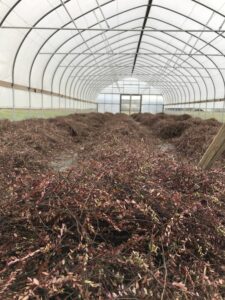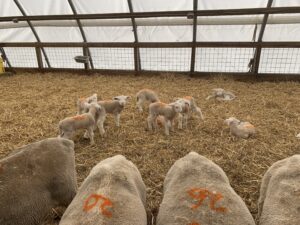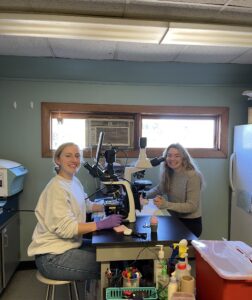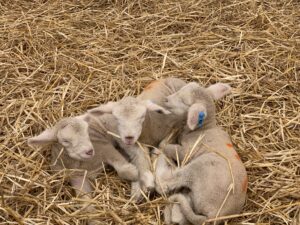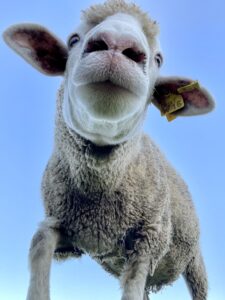Final report for LNE19-381
Project Information
Gastrointestinal nematodes (GIN) are associated with increased mortality and reduced performance of small ruminants (SR) in pasture-based operations due primarily to the blood-feeding GIN, Haemonchus contortus, more commonly known as the barber pole worm. The barber pole worm commonly causes weight loss and anemia and in severe cases death. Young animals, such as lambs, are particularly susceptible due to their immature immune system. In addition, females are more susceptible to GIN during the periparturient period (late gestation to early lactation) because of immune suppression. Producers struggle to control GIN in lambs and periparturient ewes because of increasing parasite resistance to commercial dewormers, a lack of effective alternatives to chemical dewormers, and, in most cases, an inability to accurately identify individuals that are genetically less susceptible to parasite infection. Effective tools for parasite control exist; the challenge is making these techniques widely available. The current project focused on improvement and expansion of an online training program to detect barber pole worm infections in sheep as well as a focus utilization of genetic selection for parasite resistant breeding stock.
The primary beneficiaries of this project were northeastern producers concerned about the deleterious effects of GIN infections in their sheep and goats. We updated and condensed the existing videos of our English online IPM/FAMACHA© certification program, which enabled producers to detect anemia caused by the barber pole thus identifying animals that either needed to be dewormed or culled from the flock. A Spanish language version of the program was developed thereby increasing access to this material by a more culturally diverse audience. We developed a facilitated group format for the online program for producers who struggle with or have limited internet access. A group-based format also allowed us to offer this program to extension and youth groups as well as classes of agriculture, veterinary students.
Additionally, we offered workshops with a focus on selective breeding for GIN parasite resistance through the use of estimated breeding values (EBV) for parasite resistance. Producers were introduced to the benefits of enrolling in the National Sheep Improvement Program (NSIP), a non-profit organization that promotes and facilitates the use of genetic selection for economically important production traits, such as parasite resistance. Producers were able to participate in a fecal egg count (FEC) analysis program which enabled them to generate EBVs for parasite resistance through NSIP.
Our previous research investigated the anti-parasitic potential of cranberry vine (CV) to control GIN in lambs and found that there was an increased ability to control progression of GIN infection in these young animals. In the current project we evaluated the anti-parasitic efficacy of feeding CV to periparturient ewes, a challenging period for producers to manage. The primary objective of our research was to determine the anti-parasitic potential of CV feeding on periparturient ewes.Feeding trials carried out in 2020, 2021, and 2022 supplemented periparturient ewes with a formulated cranberry vine produced pellet during winter into early spring of each year to determine anti-parasitic properties on the ewe. Ewes were fed from four weeks prior to parturition through 8 weeks of lactation. Weekly FEC and FAMACHA© anemia scores were determined and biweekly milk samples were collected for compositional analysis. Lambs were monitored for growth. Data from 2020, 2021, and 2022 trials did not indicate an anti-parasitic effect on CV supplementation in vivo in periparturient ewes and consequently cannot be recommended to producers to feed to their pregnant ewes.
Farmers increased their knowledge and practice of best management practices for the control of GIN in sheep and goats. Hundreds of producers were trained and developed proficiency with the use of FAMACHA© anemia scoring to detect barber pole worm infection in their sheep and goats. Additionally, farmers were able to collect and have analyzed fecal egg counts for use in the generation of estimated breeding values for parasite resistance in sheep. These strategies enable farmers to reduce their dependence on chemical dewormers and provide a more sustainable, profitable future for small ruminant production.
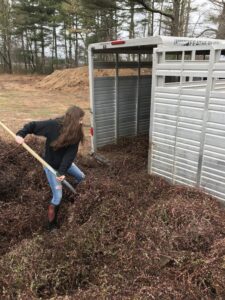
Fig. 2: Cranberry vine being dried in rows at URI's Agronomy farm
Fig 3: URI Peckham Farm Dorset ewes and offspring on study
Fig. 4: Students running fecal egg counts
Fig. 5: URI Dorset lambs born to ewes on study
Fig. 6: URI Dorset 'Peaches' - student favorite
Four hundred small ruminant (SR) producers, who have reported problems with parasites in the past five years, will introduce or improve integrated parasite management practices including genetic selection for resistance. These behaviors will result in reduced death and productivity losses totaling $428,750.
Problem and Justification:
Gastrointestinal nematodes (GIN) are associated with increased mortality and reduced performance of small ruminants (SR) in pasture-based operations. In addition, females are more susceptible to GIN during the periparturient period (late gestation to early lactation) because of immune suppression. Producers struggle to control GIN in lambs and periparturient ewes because of increasing parasite resistance to commercial dewormers, a lack of effective alternatives to anthelmintics, and, in most cases, an inability to accurately identify individuals that are genetically less susceptible to infection. Effective tools for parasite control exist; the challenge is making these techniques widely available.
Solution and Approach:
The primary beneficiaries of this project were northeastern producers concerned about the deleterious effects of GIN infections in their sheep and goats. We updated and condensed the existing videos of our existing online IPM/FAMACHA© certification program (LNE15-342) and then transcribed and translated the program into Spanish, thereby increasing access to this material by a more culturally diverse audience. We developed a facilitated group format for producers who struggle with or have limited internet access. A group-based format also allowed us to offer this program to extension and youth groups as well as classes of agriculture, veterinary students.
We offered workshops with a focus on selective breeding for GIN parasite resistance through the use of estimated breeding values (EBV) for parasite resistance. Producers were introduced to the benefits of enrolling in the National Sheep Improvement Program (NSIP), a non-profit organization that promotes and facilitates the use of genetic selection for economically important traits. Producers were also supported with fecal egg count (FEC) analysis to enable them to generate EBVs for parasite resistance through NSIP.
Our research investigated the anti-parasitic potential of cranberry vine (CV) to control GIN in lambs. We evaluated the anti-parasitic efficacy of feeding CV to periparturient ewes, a challenging period for producers to manage.
Cooperators
- (Educator and Researcher)
- (Educator)
- (Educator)
- (Educator and Researcher)
- (Educator and Researcher)
- (Educator)
Research
Hypothesis 1: The inclusion of dried cranberry vine into the diet of periparturient ewes will enhance ewe and lamb performance and health indicators.
Objectives:
1) Determine the anti-parasitic potential of CV feeding on periparturient ewes.
2) Determine the utility of CVP fed to periparturient ewes on producer farms.
Hypothesis 2: A selection index containing GIN indicator and production traits will identify profitable sheep for pasture-based systems.
Objectives:
3) Analyze historical data to estimate genetic and non-genetic parameters of and between GIN indicator and production traits.
4) Derive economic values of traits and develop a multiple-trait selection index.
Objective 1: Determine the anti-parasitic potential of CV feeding on periparturient ewes.
Feeding trials carried out in 2020, 2021, and 2022 supplemented periparturient ewes with a formulated cranberry vine produced pellet during winter into early spring of each year to determine anti-parasitic properties on the ewe.
In 2020, a pelleted 50% cranberry vine pellet was produced and formulated to be equivalent in digestible dry matter to the control feed (18% protein, Kalmbach Feeds, Sandusky, OH). Four weeks (-4) prior to parturition (day=0) dorset ewes were assigned to one of two treatment groups (n=12) and either fed 1.4 kg of a 0% CV pellet or control grain twice daily through 8 weeks of lactation. Weekly FEC and FAMACHA© anemia scores were determined, biweekly packed cell volume (PCV) was determined to monitor parasitic infection. Biweekly milk samples were collected after birth (day=0) until eight weeks of lactation to determine somatic cell count (SCC) and compositional analysis. Lambs were monitored weekly for growth.
The studies for years 2021 and 2022 followed the study design outlined above in 2020. The cranberry vine pellet was reformulated in 2022 to optimize the Copper and molybdate ratio and be more comparable to the control pellet. Twenty-five and sixteen dorset ewes were utilized in 2021 and 2022 respectively following 2020’s study design outlined above.
Objective 2: Determine the utility of CVP fed to periparturient ewes on producer farms.
Due to the lack of antiparasitic efficacy of the CVP in periparturient ewes coupled with the continued issue with elevated copper levels within the vine, producer farms were not utilized during this project to test the CVP.
Objective 3: Analyze historical data to estimate genetic and non-genetic parameters of and between GIN indicator and production traits and 4: Derive economic values of traits and develop a multiple-trait selection index.
Due to the unexpected lack of personnel to perform the extensive data analysis needed for this project, these objectives were not able to be completed.
Due to the poor nutritional quality of the cranberry vine it was difficult to formulate a supplemental pellet composed of 50% cranberry vine that was nutritionally on par with the control pellet. The pellet that was used for these two studies was similar in digestible dry matter but this caused imbalances in the protein content that was reflected in the milk urea nitrogen content of the lactating ewes. Furthermore, we have found the cranberry vine to be unacceptably high in copper content necessitating remedial measures to bind the copper, as at elevated levels it can be toxic to sheep. There was limited success in binding the copper in the cranberry vine pellet used in these two studies. This pellet did not pose a problem for these sheep but it was still unacceptably high in copper. We reformulated the supplemental pellet and fed periparturient ewes during the winter of 2022 a 50% pellet that contained lower levels of copper and with a nutritional profile more closely matching that of the control pellet using a similar design to the previous two trials.
Data from 2020, 2021, and 2022 trials did not indicate an anti-parasitic effect on CV supplementation in vivo in periparturient ewes. Fecal egg counts between treatment and control groups remained similar throughout the duration of the periparturient period. CV supplementation resulted in changes in some milk parameters but overall milk quality was not impacted. Ewe and lamb body weights remained constant throughout the trial years.
Although supplementation of cranberry vine pellets to lambs has demonstrated a modest ability to control progression of a GIN infection (manuscript in preparation) this was not the case when fed to ewes during the periparturient period where no anti-parasitic effect was observed. It is speculated that the inability to feed ewes similar amounts of CVP per pound of body weight to the level of parasite suppression seen in lambs was likely a factor. The complicating factor of elevated copper levels in the CVP is also an issue for sheep producers as copper is toxic to sheep, much more so than in goats, thereby necessitating an effective binding agent if it is to be utilized for small ruminant feed. At this time, cranberry vine pellet is not recommended for feeding periparturient ewes.
Education
The existing online IPM/FAMACHA© Certification program videos were updated and condensed, and a Spanish language version created to increase access by a more culturally diverse audience. We developed a facilitated group format for those producers with limited internet access, technology challenges and that prefer group workshop learning; as well as for students in agricultural and veterinary school classes.
We continued to offer workshops with a focus on selective breeding through the use of the EBVs for parasite resistance and other economically important traits. Producers were introduced to the benefits of enrolling in the NSIP and supported with fecal egg count (FEC) analysis to generate the data needed for the generation of FEC EBVs.
Milestones
Milestone 1: 5000 producers will receive an invitation to complete an online survey of current parasite control practices (12/31/2019). 200 producers complete online survey (04/30/20).
200
221
April 30, 2020
Completed
December 31, 2020
This milestone has been met. A Northeast region online parasite control needs assessment survey was developed and administered May through December 2020 to continue to monitor and assess parasite control concerns, priorities, and practices. Two hundred forty-four (244) small ruminant producers completed section 1 (demographics) with 221 (90.5%) completing the entire survey. Ninety-four percent (94%) of respondents came from Northeast states (DE, MD, NJ, PA, New England, NY, WV) or surrounding states that receive direct outreach through organizational email lists and Facebook posts (KY, NC, OH, TN, and VA). The number of producers reached through email lists, Facebook posts, and other organization website views following concerted outreach conducted May – June 2020 for this survey was 5,072. Actual numbers of producers reached was, in actuality, much higher as we did not have access to the number of people reached through shared social media or forwarded listservs. We also conducted a widespread reminder in September 2020.
A summary of the survey results was developed and shared on the project website. Overall, the majority of respondents confirmed that internal parasites are a common or endemic health condition and the number one most costly management issue. The majority of respondents have had problems with the barber pole worm (H. contortus) or other GI worms with nearly half indicating that they lost animals to this in the last five years.
Milestone 2: 5000 producers learn about the major components of the integrated parasite control program (IPM) each spring of the project – (4/30/20), (4/30/21), (11/30/22).
5000
19930
November 30, 2022
Completed
November 30, 2022
This milestone was met for YR 2, YR3, and YR4. Outreach for various on-going projects throughout the year was conducted. During 2020, 2021, and 2022 concentrated outreach was conducted to target producers regarding the Fecal Egg Count Analysis opportunity and follow-up surveys were conducted to assess current and planned parasite control practices. A snapshot of producers reached through email lists, Facebook posts and other organization website views during YR4 was 8,013, an increase from participants reached in YR3 (6,467) and YR2 (5,450). Actual numbers of producers reached was, in actuality, much higher as we did not have access to the number of people reached through shared social media or forwarded listservs.
Outreach for the Online FAMACHA© Certification Program occurred regularly throughout the year. The online format of the FAMACHA© Certification Program was highlighted inYR2, YR3, and YR4 through small ruminant organizations being highlighted as a virtual, online resource available to producers during COVID-19.
Milestone 3: 100 producers register for workshops (5/31/20). 90 producers attend workshops (5/31/20).
90
91
May 31, 2020
Completed
February 11, 2021
A traditional, in-person workshop series on the National Sheep Improvement Program (NSIP) and Integrated Parasite Management was originally planned for fall 2020. Due to COVID-19 restrictions, an alternative virtual 3-night workshop series consisting of pre-recorded informational videos and live Zoom sessions was held January 2021 and repeated February 2021 to allow for maximum participation. Eight (8) short videos (approximately 15 minutes each) were developed and uploaded to the URI Cooperative Extension YouTube page for participants to prepare for the live Zoom workshop series that included break-out sessions working through real-world examples of genetic selection using NSIP tools with an emphasis on parasite resistance.
Outreach began in December 2020 in YR2 and 179 producers registered for workshops with a total of 91 producers attending either series of the NSIP Virtual Workshops in YR3.
Milestone 4: 20 non- NSIP producers and 20 new/current NSIP producers will sign-up to submit samples for FEC analysis each parasite season of the project (10/31/20), (10/31/21), (11/30/22).
40
66
November 30, 2022
Completed
November 30, 2022
This milestone was met with 128 producers registered and 66 producers that participated in the summer FEC analysis program over the course of the project. In YR2, 23 producers signed up (11 NSIP Producers) with 20 producers (10 NSIP producers) participating in the FEC analysis, a total of 1,303 samples were analyzed. Thirty interested producers requested detailed information on the program, but shipping costs and labor needed to collect fecal samples during the busiest time of year (peak summer growing season) posed challenges. In YR3, 68 producers registered (24 NSIP Producers) to submit samples for FEC analysis. Twenty-one non-NSIP and one NSIP member/s did not meet the program requirements and were ineligible to participate. Twenty-seven producers (20 NSIP Producers) participated in the program submitting a total of 1,317 samples that were received and analyzed.Targeted outreach was conducted during 2022, with 37 producers registered (22 NSIP Producers) to submit samples for FEC analysis. Nineteen producers participated (15 NSIP Producers) in the program submitting a total of 1,218 samples that were received and analyzed.
Milestone 5: 120 producers and 3 producer groups register for online training (12/31/20). 90 producers and 2 producer groups complete online training (12/31/20).
90
89
December 31, 2020
Completed
December 31, 2020
This milestone was nearly met for participants completing the training (89), and it was exceeded for participants registering for the training (159). Since the completion of LNE15-341 (October 31, 2019), 134 new participants have started the training with 86 completing it as of January 1, 2021. In addition, 3 participants who started the training in a prior reporting year completed it during this year for a total of 137 online trainings initiated and 89 completed for YR2. These numbers do not include an additional 12 participants who have watched the required videos and requested the link to the post video summary but have not completed it to date; and 13 agricultural high school students who began the training but were unable to complete it due to COVID-19 school closures and restrictions.
The group facilitated approach takes an already online, virtual training program and brings it to a traditional in-person format for the purposes of assisting underserved producers with technology resources (internet or technology know-how); or providing agricultural high school and college classes with animals and guidance from a trained facilitator. With regards to group facilitated trainings: 2 group trainings were scheduled with Cornell Cooperative Extension for May and September 2020 but were canceled due to COVID-19 restrictions. A Connecticut agricultural senior high school class was in progress with the training during March 2019 but was unable to complete the FAMACHA© scoring demonstration video portion due to school closure to in-person learning. A different teacher from the same high school initiated the training in October 2020, however, the hybrid schedule of in-person and distance learning posed challenges with access to the school’s animals as well as a cohesive class approach. In the end, students were given the option to complete the training on their own if desired, but it was not conducted as part of a teacher facilitated group class. Out of 6 students initiating the training, 3 completed it and were included in the individual reporting numbers.
There was interest from a total of 12 people/groups regarding group facilitated classes and many were not pursued due to COVID-19 restrictions. This group facilitated approach was not available to some interested parties until COVID-19 restrictions were relaxed.
Prior to April 2020, this was the first and only Online FAMACHA© Certification program in the U.S. Due to COVID-19, three universities (mid-Atlantic and southeast U.S.) developed two online FAMACHA© certification training programs that were modeled after the URI program. This was prompted by an effort to transform and conduct traditional in-person workshops that were scheduled for April and May 2020 to a virtual format in direct response to COVID-19 restrictions. Despite the development of similar online training programs, we still received many requests for participation and/or more information from around the region, country and world. This online training program resulted in several email consultations and requests for general information about the FAMACHA© system. It should be noted that the webpage housing the online training program instructions received 9,052 unique page views (85.6% U.S.) from November 1, 2019 - October 31, 2020 which was one year after completing the former LNE15-342 project that tracked this information through October 31, 2019.
Milestone 6: 150 producers respond to follow-up surveys on: 1) IPM practices and impact after attending IPM or NSIP workshops, 2) Successes and/or challenges associated with generation of EBVs (4/30/21).
150
316
April 30, 2021
Completed
May 31, 2021
Online follow-up surveys were conducted with YR 2 program participants beginning winter 2021 to track program effectiveness and practices planned, improved and adopted as a result of this project.
An optional program evaluation conducted at the end of the online FAMACHA© training post video assessment indicated the following from November 1, 2019 – December 20, 2020:
113 producers indicated plans to adopt at least one practice as follows:
- 77% FAMACHA scoring
- 63% FEC
- 50% Targeted selective deworming
- 49% Genetic Selection – select animals with resistance to parasites
- 47% Genetic Selection – cull animals highly susceptible to parasites
- 43% Maintain a minimum 4-inch pasture forage height
- 42% Implement new pasture management strategies
- 42% Plant a forage containing condensed tannins
This Milestone was met for YR 3; 316 unique participants responded to follow-up surveys on integrated parasite management practices (IPM), the impact of IPM practices after attending workshops and successes and/or challenges associated with the generation of estimated breeding values (EBVs). Follow-up surveys indicate producers already utilize IPM such as FAMACHA scoring and targeted selective deworming and plan to adopt additional IPM techniques such as, fecal egg counts, deworming and quarantining new animals, EBVs and utilizing genetic selection in breeding/culling decisions. From the NSIP virtual 2021 workshops participants that completed the follow-up survey (19), 63.15% indicated their knowledge about the purpose and use of EBVs for economically important traits increased a considerable amount. 52.63% of participants indicated that their knowledge about the use of fecal egg counts in generating EBVs for parasite resistance increased a considerable amount. Participants stated how useful EBVs have been for selecting replacement animals, improving a variety of traits in their flock and especially utilizing the FEC EBV to improve parasite resistance.
Milestone 7: 125 producers register for workshops (5/31/21). 90 producers attend workshops (5/31/21).
90
91
May 31, 2021
Completed
February 19, 2021
A traditional, in-person workshop series on the National Sheep Improvement Program (NSIP) and Integrated Parasite Management was originally planned for fall 2020. Due to COVID-19 restrictions, an alternative virtual 3-night workshop series consisting of pre-recorded informational videos and live Zoom sessions was scheduled for January and February 2021. Eight (8) short videos (approximately 15 minutes each) were developed and uploaded to the URI Cooperative Extension YouTube page for participants to prepare for the live Zoom workshop series. The workshop included break-out sessions working through real-world examples of genetic selection using NSIP tools with an emphasis on parasite resistance. Links to the videos and registration information is available on the project webpage, https://web.uri.edu/sheepngoat/nsipworkshops/. Outreach began in December 2020, 179 producers registered for the workshop and 91 producers attended one series of the NSIP Virtual Workshop.
Milestone 8: 160 producers and 4 producer groups register for online training (12/31/21). 120 producers and 3 producer groups complete online training (12/31/21).
120
175
December 31, 2021
Completed
December 31, 2021
This milestone was met for YR3 with 175 participants and four producer groups registered for the online training program; 133 participants and three producer groups completed the training. Three agricultural high schools completed the online facilitated training in YR3 that resulted in the certification of 86 high school participants. The launch of the new English format of the online training program occurred December 2021 and the Spanish format was launched in May 2022. The new formatted programs consisted of four short videos (approximately 15 minutes each) and a post-video assessment available to participants upon completion of the four videos. Links to the online training videos and post-video assessment were available on the project webpage, https://web.uri.edu/sheepngoat/famacha/.
Milestone 9: 125 producers register for workshops (11/30/22). 120 producers attend workshops (11/30/22).
120
173
November 30, 2022
Completed
November 30, 2022
This is a summary of all producers registering and participating in NSIP workshops throughout the duration of the project. In YR3 179 producers registered and 91 producers attended the virtual 3-night National Sheep Improvement Program (NSIP) workshop. In YR4 258 producers registered and 82 producers attended the virtual one-night NSIP workshop. A total of 173 producers participated in NSIP workshops over the life of the project.
Milestone 10: 120 producers and 3 producer groups register for online training (11/30/22). 90 producers and 2 producer groups complete online training (11/30/22).
90
355
November 30, 2022
Completed
November 30, 2022
This is a summary of all producers that have participated in the online FAMACHA© Certification Training program as individuals or within a facilitated group format
In YR2, 89 producers and one facilitated group completed the online FAMACHA© certification program. In both YRS 3 and 4, 133 people including 3 facilitated groups participated each year with a grand total of 355 people completing the online FAMACHA© Certification program with seven facilitated groups over the life of the project.
Milestone 11: The project team will be in direct communication via email or phone with project participants. Thirty new or current NSIP producers will generate FEC EBV for their animals that will be shared with project staff (11/30/22).
30
45
November 30, 2022
Completed
November 30, 2022
This milestone has been met. A total of 45 NSIP producers, over the life of this project, participated in the summer FEC analysis component of this project and later submitted the FEC results on their lamb crop to NSIP for the generation of FEC EBVs.
Milestone 12: 250 producers respond to follow-up surveys on: 1) IPM practices and impact after attending IPM or NSIP workshops, 2) Successes and/or challenges associated with generation of EBVs (11/30/22).
250
499
October 31, 2022
Completed
November 30, 2022
Online follow-up surveys were conducted throughout the project to assess impact after attending IPM/workshops, adoption of IPM practices, and successes and/or challenges associated with generation of EBVs. Over the life of the project 341 unique participants responded to follow-up surveys on integrated parasite management practices (IPM), the impact of IPM practices after attending workshops and successes and/or challenges associated with the generation of estimated breeding values (EBVs). Producers' responses highlighted the knowledge gained and importance of genetic selection (FEC and EBVs) in selecting for parasite resistant stock. An additional 158 producers completed an optional program evaluation conducted at the end of the online FAMACHA© training post video assessment indicated the following IPM adoption plans:
- 81.6% FAMACHA scoring
- 63.4% FEC
- 57.2% Targeted selective deworming
- 79.37% Genetic Selection – select animals with resistance to parasites
- 48.80% Genetic Selection – cull animals highly susceptible to parasites
- 42.78% Maintain a minimum 4-inch pasture forage height
- 42% Plant a forage containing condensed tannins
Milestone Activities and Participation Summary
Educational activities:
FEC analysis: 3838 fecal samples were analyzed for internal parasite eggs and producers received results (some of these animals were sampled twice); English and Spanish video development and close captioning; translation of website FAMACHA training instructions into Spanish; development of short videos for virtual NSIP workshops; updating project material.
Participation Summary:
Learning Outcomes
Key areas in which farmers reported changes in knowledge, attitude, skills and/or awareness:
An optional program evaluation is administered at the end of the online post video assessment. One-hundred and fifty-eight producers, of the 355 that completed the online FAMACHA Certification program, completed an optional program evaluation conducted at the end of the online FAMACHA© training post video assessment indicated the following IPM adoption plans:
- 81.6% FAMACHA scoring
- 63.4% FEC
- 57.2% Targeted selective deworming
- 79.37% Genetic Selection – select animals with resistance to parasites
- 48.80% Genetic Selection – cull animals highly susceptible to parasites
- 42.78% Maintain a minimum 4-inch pasture forage height
- 42% Plant a forage containing condensed tannins
Producers completing the Online FAMACHA© Certification Program post-summary survey averaged 80.02%, indicating the majority of participants retain key knowledge after watching the Certification Program Videos.
One-hundred and twenty-nine participants in the older program (4/2019-12/2021) indicated an increase in knowledge on a scale of 1 (no knowledge) to 5 (considerable knowledge) after viewing program videos in one or more topics including: Gastrointestinal Nematode (GIN) worm biology and life cycle (pre 2.5, post 4.3); History and development of dewormer drug resistance (pre 2.6, post 4.4); Pasture management techniques to avoid GIN worm exposure; Information about sheep and goat immunity to GIN worms (pre 2.5, post 4.5); Smart dewormer use and drug alternatives (pre 2.3, post 2.29) ; and The FAMACHA System (pre 4.5, post 4.22).
Similarly to the older program, participant knowledge increased significantly after viewing the updated program videos. Forty-nine participants in the updated program (1/2022-10/2023) indicated an increase in knowledge in one or more of the previously stated topics after viewing the program videos: Gastrointestinal Nematode (GIN) worm biology and life cycle (pre 2.24, post 4.12); History and development of dewormer drug resistance (pre 2.49, post 4.16); Information about sheep and goat immunity to GIN worms (pre 2.5, post 4.5); Smart dewormer use and drug alternatives (pre 2.3, post 2.29 ; and The FAMACHA System (pre 4.5, post 4.22).
An in-person workshop on small ruminant parasite control was conducted for RI 4-H youth and their families (34 youth and 30 adults), February 2020. Twenty-eight (28) youth completed a post workshop evaluation: 100% of respondents indicated that they gained new knowledge and will apply the new skills they learned; and 93% will use the information to make future decisions.
Performance Target Outcomes
Target #1
400
Will introduce or improve integrated parasite management practices including genetic selection for resistance.
$428,750
These behaviors will result in reduced death and productivity losses.
421
Adoption of FAMACHA anemia scoring coupled with best management practices for integrated parasite control. Some producers used fecal egg count analysis to select animals with genetic resistance to parasites and some producers also used the FEC data to generate the estimated breeding values for parasite resistance with NSIP.
$378,778
Reduced death and productivity losses
The following assumptions outlined were based upon the scientific literature, government census data and market values.
West et al, 2009 (Estimating the cost of subclinical parasitism in grazing ewes) Small Ruminant Research 86:84-86.
Assumptions from this paper:
- There were 12 more fetuses per 100 ewes in animals in which parasitism was minimized
- Mean body weight increase of 2.5 lbs/lambs *$2 value of that increased product (New Holland Sales, PA)
USDA APHIS 2020
- 60% of all lamb mortality is due to non-predator causes
- 15.5% of all lamb mortality of non-predator death loss is caused by internal parasite
- Therefore 15.5% of the 60/100 lambs lost = 9 lambs or 9% of 100
- Therefore, utilization of FAMACHA alone will prevent the 9% in lamb mortality from parasites due to early detection.
There were 251 of the 355 total individuals that completed the FAMACHA certification program that were adult producers (non-youth segment subtracted from total). These individuals demonstrated their ability to determine the FAMACHA score on sheep or goats. These producers, through the use of FAMACHA in their flocks would:
- Prevent the 9% death loss of lamb crop to internal parasites
- Online FAMACHA certified producers were not asked to provide flock specific information as we felt this would be a barrier to participation. Therefore the USDA Census of Agriculture (2017) numbers were utilized to estimate the average number of breeding ewes per operation within each state. We then estimated a 150% lamb crop (half single/half twins). Prevention of the 9% mortality loss to internal parasites was calculated from the lamb crop X 0.09 = number of lambs not lost to parasites due to use of FAMACHA multiplied by the market price per 100 lbs (www.sheep101info/201/budget.html) of lamb ($217.25) minus the processing fee ($21.97).
- The 251 producers collectively represented 5427 ewes * 1.5 = 8139 lamb crop * 0.09 = 732 lambs not lost to internal parasites * (217.25 - 21.97) = $143,062 loss prevention
There were 66 producers that participated in the fecal egg count analysis program run every summer of the project. These producers were all FAMACHA certified, and all selecting for parasite resistance in their breeding stock therefore the following assumptions were made based upon the information sources above:
-
- Prevention of 9% death loss of lamb crop to internal parasites (as explained above) (66 producers participating in FEC program submitted 6104 lamb samples * 0.09 = 549 lambs not lost to internal parasites * (217.25 - 21.97) = $107,279 loss prevention
- 12 more fetuses per 100 ewes in animals in which parasitism is minimized (those selected for parasite resistance): 4439 ewes /100 ewes = 44.39 *12 more fetuses/100 ewes = 532 fetus * (217.25 - 21.97) = $104,021 more income from more fetuses
- Prevention of subclinical losses. Increase of 2.5 lbs of weight in lambs born to ewes in which parasitism was minimized: 6104 lamb crop * 0.8 (subtracting 20% for replacements animals) = 4883 *2.5 lbs increased weight * $2/lb weight = $24,416 increase in value from prevention of subclinical losses.
- Total reduction in mortality and increased productivity = $235,716
Total realized for online certified producers plus producers selecting for resistance through the use of fecal egg counts = $378,778
Additional Project Outcomes
Quotes from producers:
"This project helps us cover the costs and to be able to sample more sheep."
"With the constant pressures of public perception and the limited availability of new drug research and adoption, going back to genetic prevalence is key to sustaining this industry. In order to validate genetic data, on farm data collection is a must. I hope this program can continue."
"Please continue the program. It is easy to participate and your information is clear and easy to follow."
"This was a well paced program. The amount of information helped me understand the biology of goats and parasites. I learned a great deal and will use this with my high school students! Thank you very much!"
"I am a veterinarian and found this super helpful for myself as well as my clients!"
Information Products
- Northeast Small Ruminant Parasite Control Website (Website)
- Video: Part 1 - Introduction to the National Sheep Improvement Program (NSIP) (Video)
- Video: Part 2 - How do Estimated Breeding Values Work? (Video)
- Video: Part 3 - Estimated Breeding Values in Practice (Video)
- Video: Case Study Using NSIP Estimated Breeding Values; Part 1 – Producer Progress Using NSIP (Video)
- Video: Case Study Using NSIP Estimated Breeding Values; Part 2 – Producer Progress Profitability (Video)
- Video: Weeding Out the Wormy Ones; Part 1 - Being a Worm (Video)
- Video: Weeding Out the Wormy Ones; Part 2 - Managing Worms (Video)
- Video: Weeding Out the Wormy Ones; Part 3 - Genes and Worms (Video)
- Part 1: An Intro to Worm Basics (Video)
- Part 2: Utilizing Dewormers (Video)
- Part 3: Integrated Parasite Management (Video)
- Part 4; Utilizing the FAMACHA System (Video)
- Parte 1: Introducción (Video)
- Parte 2: Uso de antihelmínticos y control de parásitos (Video)
- Parte 3: Manejo Integrado de Parásitos (Video)
- Parte 4: Usando el sistema FAMACHA© (Video)
- Fecal Egg Count Interpretation Document (Fact Sheet)
